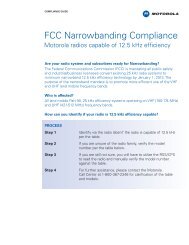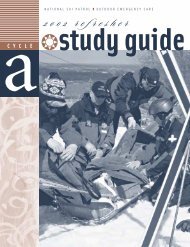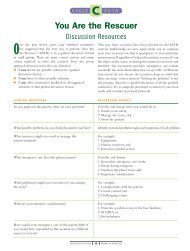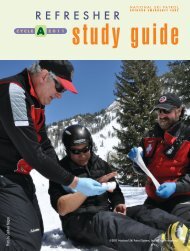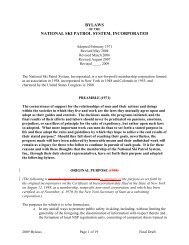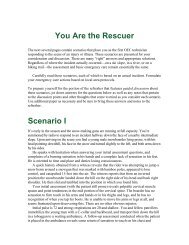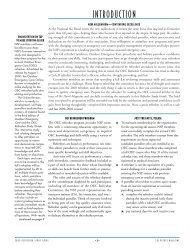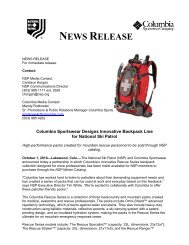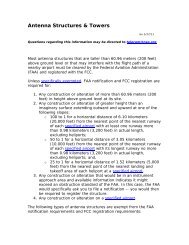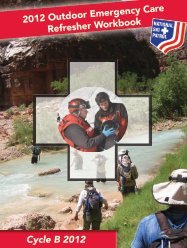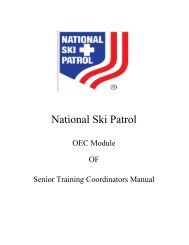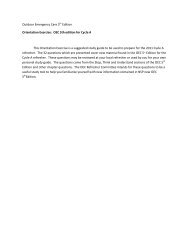2003 refresher - National Ski Patrol
2003 refresher - National Ski Patrol
2003 refresher - National Ski Patrol
- No tags were found...
You also want an ePaper? Increase the reach of your titles
YUMPU automatically turns print PDFs into web optimized ePapers that Google loves.
NATIONAL SKI PATROL ❚ OUTDOOR EMERGENCY CARE<br />
B ❂<br />
C Y C L E<br />
<strong>2003</strong> <strong>refresher</strong><br />
study guide<br />
BRIAN W. ROBB
Introduction<br />
J<br />
Reality Programming<br />
Judging by recent trends in television programming, people just can’t seem to get enough reality. Viewers<br />
can watch everything from distrustful castaways surviving challenges in exotic locales to crazed individuals<br />
doing battle with each other and their various phobias. Change the channel and they might see police officers<br />
in hot pursuit of a car thief or housemates getting caught up in a quagmire of personality conflicts.<br />
Imagine, for a moment, a new series—one in which hidden cameras are placed in your patrol facilities<br />
and your ski hat is outfitted with a “patroller cam.” What sort of “reality” would viewers see when they<br />
tuned in What would you want them to see<br />
It can be unnerving to feel the eyes of a vigilant audience watching your every move, but as you’ll discover<br />
at your Outdoor Emergency Care <strong>refresher</strong> this fall, it can also help you focus on the proper application<br />
of skills. And after awhile, those skills become second nature to you and confidence replaces any<br />
trepidation you might have felt initially.<br />
This patroller cam idea might sound a bit far-fetched, but the truth of the matter—the reality—is that<br />
we serve in the public eye and project a certain image as we perform our patrol duties. The public often<br />
takes us for granted and assumes that we will be there to assist in case of an emergency. They assume correctly.<br />
That’s what we’re there for.<br />
Of course, there’s more to our reality than the public might perceive. Like all this new television programming,<br />
patrolling is unscripted so we never know what we’re going to encounter on any given day in<br />
the aid room or on the hill. We do know, however, that there are certain kinds of injuries that are more<br />
common than others.<br />
It’s true that the outdoor sports industry gets more exciting each season, with innovations in equipment<br />
and recreational possibilities. It’s also true that these developments give people more ways to enjoy<br />
themselves and more opportunity to injure themselves. Despite new gear options and evolutions in sport,<br />
however, many of the injuries managed by nonurban rescuers share similar characteristics.<br />
To help you respond more effectively to these types of injuries, the Outdoor Emergency Care Refresher<br />
Committee has modified the <strong>refresher</strong> cycles slightly to ensure that patrollers refresh on “Common<br />
Outdoor Injury Management” annually. In fact, this year’s Cycle B <strong>refresher</strong> treats it as an “in-depth” topic.<br />
This change is intended to help you focus on the most common injuries you see each year, which include<br />
shoulder girdle, forearm/wrist, and knee injuries. You will review the mechanisms and patterns of these<br />
injuries, the anatomy and physiology involved, and the emergency care for each. This information will be<br />
woven into skills stations and/or scenario presentations.<br />
Apart from your on-the-hill experience, your annual OEC <strong>refresher</strong> is often the only hands-on opportunity<br />
you have to demonstrate proficiency in new emergency care challenges. The NSP helps prepare<br />
you to meet such challenges by apprising you of the latest trends in both the snowsports industry and in<br />
emergency response and care. The OEC Refresher Committee assists with this by developing and recommending<br />
training materials that will help you optimize your OEC <strong>refresher</strong> experience.<br />
The annual <strong>refresher</strong> is designed to prepare you for the coming season’s challenges by offering many<br />
opportunities to fine-tune your skills, with no time constraints imposed. It is also a time for you to work<br />
with your peers, individually and in teams. Proving that you can perform a series of specific skills says<br />
something about your abilities, but the real test comes when you’re the first responder on the scene and<br />
the “patroller cam” is on.<br />
Your instructors act as facilitators who present ways for you to review important skills and content.<br />
They are there to help you improve your old skills, possibly acquire some new ones, and do whatever is<br />
necessary to help you continue to be a confident and effective rescuer. Remember that, ultimately, your<br />
<strong>refresher</strong> experience will only be as good as the effort you put into it.<br />
<strong>2003</strong> Refresher Study Guide ❚ 2 ❚ <strong>Ski</strong> <strong>Patrol</strong> Magazine
❚<br />
❚<br />
❚<br />
❚<br />
❚<br />
Refresher Program<br />
The OEC <strong>refresher</strong> program provides OEC<br />
technicians with a continuing education opportunity<br />
to renew and demonstrate competency<br />
in required OEC knowledge and skills while<br />
using a variety of equipment and techniques.<br />
To maintain membership in the NSP for the<br />
upcoming ski season, members must successfully<br />
complete the annual OEC <strong>refresher</strong>. The<br />
only NSP members exempt from this requirement<br />
are those registered candidate patrollers<br />
who are enrolled in an OEC course, those<br />
members who completed a full OEC course<br />
after May 31 of the current calendar year, and<br />
those members who are registered as medical<br />
associates (M.D.’s and D.O.’s).<br />
A <strong>refresher</strong> is not the equivalent of a challenge<br />
for a candidate patroller entering the NSP<br />
system with previous emergency care or<br />
medical training.<br />
A patroller who wishes to renew active status<br />
from an inactive registration or a missed<br />
patrolling season must complete the <strong>refresher</strong><br />
cycle(s) missed during the inactive period.<br />
(Only those patrollers with a non-expired<br />
OEC certification may renew their certification<br />
by making up missed <strong>refresher</strong>s. Speak<br />
with an instructor if you have a current OEC<br />
certification and need to coordinate a makeup<br />
<strong>refresher</strong>.)<br />
<strong>Patrol</strong> training usually includes local patrol,<br />
area, and resort protocols not contained within<br />
NSP’s Outdoor Emergency Care Program, and<br />
these skills are often taught in courses that run<br />
concurrent with OEC training. The NSP is<br />
not responsible for the content, instruction,<br />
or scheduling of these additional classes. Your<br />
<strong>refresher</strong> may cover these non-NSP topics<br />
of instruction, which include:<br />
❚ CPR or AED certification<br />
❚ Chairlift evacuation procedures<br />
❚ Additional local patrol dryland or<br />
on-the-hill training<br />
Each patroller should consult with his or her<br />
local patrol, area, or resort for schedules, topics<br />
to be covered, and other requirements.<br />
❚<br />
❚<br />
❚<br />
❚<br />
❚<br />
❚<br />
❚<br />
❚<br />
❚<br />
❚<br />
Get Ready<br />
It’s your responsibility to check with your<br />
patrol or region to determine when and where<br />
the <strong>refresher</strong> will be held. If you have a conflict,<br />
contact the OEC region administrator or check<br />
your division website for an alternate date.<br />
Do not wait until the last minute to do this.<br />
Please notify your patrol representative in<br />
advance if you will not be able to attend your<br />
patrol’s <strong>refresher</strong>. Prearrange attendance at<br />
another <strong>refresher</strong> with the instructor of record<br />
or patrol representative for that area.<br />
Allow yourself plenty of time to study the Outdoor<br />
Emergency Care references listed in this<br />
study guide for Cycle B. All references are to<br />
the fourth edition of Outdoor Emergency Care.<br />
Review the <strong>refresher</strong> topics for this cycle.<br />
Read the “Scenario Discussion Forum” section<br />
of this study guide, write answers to the text<br />
questions and action questions that follow<br />
each scenario, and bring your answers to the<br />
<strong>refresher</strong>. This forum is also available as a<br />
downloadable Word or PDF document in the<br />
Education/OEC section of the NSP website at<br />
www.nsp.org.<br />
Use the skill guides in this study guide and<br />
in the fourth edition OEC text to review and<br />
practice the skills you will be asked to demonstrate<br />
during this year’s <strong>refresher</strong>.<br />
Dust off your aid belt, vest, or pack; restock it;<br />
and be ready to go!<br />
Requirements (What to Bring)<br />
The <strong>2003</strong> Refresher Study Guide with completed<br />
Scenario Discussion Forum text and action<br />
questions.<br />
Your current OEC, CPR, and NSP member<br />
cards. (You may obtain a duplicate OEC card<br />
from the national office by mailing a check or<br />
money order for $5 [made payable to NSP] to<br />
the national office at 133 South Van Gordon<br />
Street, Suite 100, Lakewood, Colorado 80228.<br />
Enclose a note asking for a new OEC card and<br />
allow three to four weeks for delivery.)<br />
A fully stocked aid belt, vest, or pack and any<br />
additional items required at the <strong>refresher</strong><br />
you will be attending. Dress appropriately to<br />
participate in both indoor and outdoor<br />
<strong>refresher</strong> activities.<br />
R YOU READY TO ROLL<br />
This season, use the<br />
following list of R’s to<br />
help you get the most<br />
out of your training.<br />
Refresh your OEC skills<br />
and knowledge to be as<br />
sharp as possible when<br />
you respond to an<br />
accident scene.<br />
Refresher<br />
Review content<br />
Remediate problems<br />
Recall information<br />
Remember the facts<br />
Retain the knowledge<br />
Reinforce the skills<br />
<strong>Patrol</strong>ling<br />
Respond to the call<br />
React to the scene<br />
Remedy the situation<br />
Rescue the injured<br />
<strong>Ski</strong> <strong>Patrol</strong> Magazine ❚ 3 ❚ <strong>2003</strong> Refresher Study Guide
Record Keeping<br />
❚ If you attend another region or patrol’s<br />
<strong>refresher</strong>, be sure to fill out the “Supplemental<br />
Roster Information” form on page 5 of this<br />
study guide and submit it to the instructor of<br />
record. This will ensure that the instructor has<br />
all the information he or she needs to verify<br />
your completion of the <strong>refresher</strong> on a roster<br />
submitted to the national office: your NSP<br />
membership ID number, name as it appears in<br />
national registration records, address, and<br />
patrol affiliation. To document your attendance<br />
for your patrol representative, use the “Completion<br />
Acknowledgment” form on page 5.<br />
❚ Make sure the instructor of record signs and<br />
dates your OEC card on the line for Cycle B<br />
and returns it to you.<br />
❚ Also, please complete and hand in the “<strong>2003</strong><br />
Cycle B OEC Refresher Assessment and<br />
Evaluation” form on page 23.<br />
❚<br />
❚<br />
❚<br />
CPR Policy<br />
All active NSP members must hold a current<br />
Professional Rescuer CPR certification from<br />
the American Heart Association, the American<br />
Red Cross, the <strong>National</strong> Safety Council, the<br />
American Health and Safety Institute, or<br />
Medic First Aid.<br />
The certifying body need not issue a new certificate<br />
unless the certificate expires before the<br />
start of the upcoming ski season.<br />
All active NSP members must demonstrate<br />
their CPR skills each season, regardless of the<br />
certifying agency’s requirements or the expiration<br />
date on the card.<br />
Cycle B Refresher Topics<br />
A. ANNUAL TOPICS<br />
1. Common Outdoor Injury Management<br />
(in-depth topic)—chapters 14, 24, and 25<br />
(This and all of the following chapter<br />
references are for the fourth edition<br />
OEC textbook)<br />
2. Neurological Injury Management<br />
(in-depth topic)—chapter 26<br />
3. Patient Assessment—chapters 7 and 30<br />
4. Airway Management and Oxygen<br />
Administration—chapter 6<br />
5. Shock Management—chapter 9<br />
6. Cold-Injury Management—chapters 2 and 15<br />
B. CYCLE-SPECIFIC TOPICS<br />
1. Anatomy and Physiology—chapter 4<br />
❚ Musculoskeletal System<br />
❚ Nervous System<br />
❚ Urinary and Reproductive Systems<br />
(also chapter 23)<br />
2. Orthopedic Trauma—chapters 24 and 25<br />
❚ Pelvis, hip, and femur injuries<br />
❚ Traction splinting<br />
❚ Spinal immobilization<br />
3. Environmental and Medical Emergencies—<br />
chapter 15<br />
❚ Environmental Injuries<br />
❚ Cold<br />
❚ Heat<br />
❚ Altitude<br />
❚ Solar<br />
❚ Electrical<br />
❚ Water Emergencies<br />
4. Specific Injuries—chapters 23 and 26<br />
❚ Injuries to the abdomen and genitalia<br />
❚ Application of a standing backboard<br />
❚ Helmet removal<br />
5. Transportation and Extrication—chapter 27<br />
❚ Positioning patients—log roll<br />
6. Local Needs<br />
<strong>2003</strong> Refresher Study Guide ❚ 4 ❚ <strong>Ski</strong> <strong>Patrol</strong> Magazine
<strong>2003</strong> CYCLE B OEC REFRESHER<br />
Completion Acknowledgement<br />
Have this signed by the instructor of record at the <strong>refresher</strong> and return it to your NSP patrol representative or patrol director to verify<br />
that you have attended and successfully completed all requirements for the <strong>2003</strong> <strong>refresher</strong>. Please print.<br />
<strong>Patrol</strong>ler:<br />
NSP Member I.D. #:<br />
<strong>Patrol</strong> Affiliation:<br />
Refresher Location and Date:<br />
Name of OEC Instructor of Record:<br />
Signature of OEC Instructor of Record:<br />
<strong>2003</strong> CYCLE B OEC REFRESHER<br />
Supplemental Roster Information<br />
After completing the <strong>refresher</strong>, fill out this form and submit it to the instructor of record. This will help the instructor document your<br />
completion of this year’s OEC <strong>refresher</strong> requirements to the national office. Please print.<br />
✁<br />
CUT HERE<br />
<strong>Patrol</strong>ler:<br />
NSP Member I.D. #:<br />
Address:<br />
City: State: Zip:<br />
E-mail Address:<br />
<strong>Patrol</strong> Affiliation:<br />
Region:<br />
Refresher Location and Date:<br />
OEC Instructor of Record:<br />
<strong>Ski</strong> <strong>Patrol</strong> Magazine ❚ 5 ❚ <strong>2003</strong> Refresher Study Guide
<strong>Ski</strong>ll Guides<br />
These are provided for review purposes. Each patroller will be required to demonstrate these skills at the <strong>refresher</strong>.<br />
(CPI) = Critical Performance Indicator<br />
Steps marked with the CPI designation are critical to proper patient care and must be demonstrated to satisfy performance criteria.<br />
Use of Oxygen and Airway Adjuncts—Oropharyngeal and Nasopharyngeal Airways<br />
Objective: To demonstrate the correct use of oropharyngeal and nasopharyngeal airways.<br />
SKILL YES NO NOTATIONS<br />
❚ Initiates BSI precautions. (CPI)<br />
❚<br />
❚<br />
Selects proper size oropharyngeal airway by measuring from<br />
the corner of the mouth to the angle of the jaw.<br />
OR<br />
Selects proper size nasopharyngeal airway by measuring from<br />
the tip of the nose to the earlobe. Coats the airway with a<br />
water-soluble lubricant.<br />
If using an oral airway, opens the mouth using an appropriate<br />
technique.<br />
❚ Inserts the airway using an appropriate technique. (CPI)<br />
❚<br />
Did the trainee or OEC technician adequately demonstrate<br />
the performance criteria of this skill<br />
OROPHARYNGEAL AIRWAY<br />
Sizes the airway.<br />
NASOPHARYNGEAL AIRWAY<br />
Opens mouth with cross-finger technique and inserts airway.<br />
Rotates airway 180° and rest flange on lips and teeth.<br />
Sizes the airway. Inserts lubricated airway into larger nostril. Rests flange against the skin.<br />
<strong>2003</strong> Refresher Study Guide ❚ 6 ❚ <strong>Ski</strong> <strong>Patrol</strong> Magazine
Use of Oxygen and Airway Adjuncts—Suctioning of the Oral Cavity<br />
Objective: To demonstrate the correct use of suctioning equipment.<br />
SKILL YES NO NOTATIONS<br />
❚ Initiates BSI precautions. (CPI)<br />
❚<br />
❚<br />
❚<br />
Assembles, turns on, and tests device.<br />
Opens the mouth using the crossed-finger technique.<br />
Inserts rigid tip catheter without applying suction (measures length<br />
from corner of mouth to angle of jaw and inserts catheter no farther<br />
than distance measured).<br />
❚ Applies suction for no longer than 15 seconds while the rigid catheter (CPI)<br />
is twisted or rotated during withdrawal.<br />
❚<br />
Did the trainee or OEC technician adequately demonstrate<br />
the performance criteria of this skill<br />
SUCTIONING THE AIRWAY<br />
Measures catheter from corner of mouth to earlobe. Opens mouth and inserts catheter to depth measured. Applies suction no more than 15 seconds.<br />
<strong>Ski</strong> <strong>Patrol</strong> Magazine ❚ 7 ❚ <strong>2003</strong> Refresher Study Guide
Use of Oxygen and Airway Adjuncts—Administration of Oxygen<br />
Objective: To demonstrate the correct use of oxygen equipment.<br />
SKILL YES NO NOTATIONS<br />
❚ Initiates BSI precautions. (CPI)<br />
❚ Assembles oxygen cylinder and regulator, and checks for leaks. (CPI)<br />
❚ Chooses a delivery device by patient need. (CPI)<br />
❚ Selects nonrebreathing oxygen mask, connects to regulator,<br />
prefills the regulator, and initially adjusts oxygen flow<br />
to 12 to 15 L/min.<br />
❚ Selects nasal cannula, connects to regulator, and adjusts oxygen<br />
to 6 L/min maximum.<br />
❚ Applies the appropriate oxygen delivery device to the patient and (CPI)<br />
verifies that the patient receives oxygen. If using a nonrebreathing<br />
mask, readjusts the flow rate to keep the bag half full on inhalation.<br />
❚<br />
When finished providing oxygen, closes the oxygen tank.<br />
❚ Bleeds regulator device to “0.”<br />
❚<br />
Did the trainee or OEC technician adequately demonstrate<br />
the performance criteria of this skill<br />
ASSEMBLING OXYGEN CYLINDER AND REGULATOR<br />
Cracks valve, briefly. Assures the use of gasket. Aligns regulator on valve stem. Attaches oxygen supply tubing.<br />
OXYGEN DELIVERY DEVICES<br />
COURTESY OF THE AMERICAN ACADEMY OF ORTHOPAEDIC SURGEONS<br />
COURTESY OF THE AMERICAN ACADEMY OF ORTHOPAEDIC SURGEONS<br />
Nonrebreathing mask<br />
Nasal cannula<br />
<strong>2003</strong> Refresher Study Guide ❚ 8 ❚ <strong>Ski</strong> <strong>Patrol</strong> Magazine
Use of Oxygen and Airway Adjuncts—Use of Pocket Mask for Artificial Ventilation<br />
Objective: To demonstrate the correct use of oxygen equipment for artificial ventilation.<br />
SKILL YES NO NOTATIONS<br />
❚ Initiates BSI precautions. (CPI)<br />
❚<br />
❚<br />
❚<br />
❚<br />
❚<br />
Assembles mask components as necessary, using device-specific,<br />
one-way valve.<br />
Sizes and inserts proper size oropharyngeal or nasopharyngeal airway<br />
using appropriate technique.<br />
Connects oxygen to pocket mask.<br />
Adjusts oxygen supply to 15 L/min.<br />
Maintains open airway and mask seal.<br />
❚ Demonstrates adequate ventilation (rate and depth) on a manikin. (CPI)<br />
❚<br />
Did the trainee or OEC technician adequately demonstrate<br />
the performance criteria of this skill<br />
OROPHARYNGEAL AIRWAY NASOPHARYNGEAL AIRWAY POCKET MASK<br />
Inserts proper size oropharyngeal or nasopharyngeal airway using appropriate technique.<br />
Maintains mask seal.<br />
<strong>Ski</strong> <strong>Patrol</strong> Magazine ❚ 9 ❚ <strong>2003</strong> Refresher Study Guide
Use of Oxygen and Airway Adjuncts—Use of Bag-Valve-Mask for Artificial Ventilation<br />
Objective: To demonstrate the correct use of oxygen equipment for artificial ventilation.<br />
SKILL YES NO NOTATIONS<br />
❚ Initiates BSI precautions. (CPI)<br />
❚<br />
❚<br />
❚<br />
❚<br />
❚<br />
Assembles bag-valve-mask components, including reservoir.<br />
Sizes and inserts proper size oropharyngeal or nasopharyngeal airway<br />
using appropriate technique.<br />
Connects oxygen supply to bag-valve-mask.<br />
Adjusts oxygen supply to 15 L/min.<br />
Maintains open airway and mask seal.<br />
❚ Demonstrates adequate ventilation (rate and depth) on a manikin. (CPI)<br />
❚<br />
Did the trainee or OEC technician adequately demonstrate<br />
the performance criteria of this skill<br />
OROPHARYNGEAL AIRWAY<br />
NASOPHARYNGEAL AIRWAY<br />
Inserts proper size oropharyngeal or nasopharyngeal airway using appropriate technique.<br />
BAG-VALVE-MASK<br />
COURTESY OF THE AMERICAN ACADEMY OF ORTHOPAEDIC SURGEONS<br />
Maintains mask seal.<br />
<strong>2003</strong> Refresher Study Guide ❚ 10 ❚ <strong>Ski</strong> <strong>Patrol</strong> Magazine
Patient Assessment—Responsive Trauma Patient<br />
Objective: To demonstrate the ability to determine the baseline condition and specific injury or injuries in a responsive trauma patient.<br />
SKILL YES NO NOTATIONS<br />
SCENE SIZE-UP<br />
❚ Initiates BSI precautions. (CPI)<br />
❚<br />
❚<br />
❚<br />
❚<br />
❚<br />
Determines that the scene is safe.<br />
Determines the nature of illness (NOI) and/or the mechanism<br />
of injury (MOI).<br />
Notes the number of patients and the responsiveness of each.<br />
Evaluates the need to disentangle or extricate the patient(s).<br />
Considers c-spine immobilization.<br />
Notes the need for personnel or equipment.<br />
(CPI)<br />
INITIAL ASSESSMENT—RESPONSIVE PATIENT<br />
❚<br />
❚<br />
Offers to assist/obtains the patient’s consent.<br />
Confirms general impression of the patient and/or level<br />
of responsiveness (LOR).<br />
❚ Assesses airway, breathing, and circulation (ABCs). (CPI)<br />
❚<br />
Assists breathing or performs CPR as necessary.<br />
❚ Checks for severe bleeding: intervention = control bleeding. (CPI)<br />
❚<br />
❚<br />
If the patient has abnormal ABCs or presents a poor general<br />
impression, the rescuer performs the rapid body survey, obtains<br />
baseline vital signs, obtains the SAMPLE history, and provides<br />
rapid transport.<br />
Obtains the chief complaint.<br />
❚ Calls for transport, equipment, assistance, and/or EMS as needed. (CPI)<br />
<strong>Ski</strong>ll Guide continued on page 12<br />
ASSESSMENT OF A RESPONSIVE TRAUMA PATIENT<br />
Determines scene safety and the mechanism of injury.<br />
<strong>Ski</strong> <strong>Patrol</strong> Magazine ❚ 11 ❚ <strong>2003</strong> Refresher Study Guide
Patient Assessment—Responsive Trauma Patient (continued)<br />
Objective: To demonstrate the ability to determine the baseline condition and specific injury or injuries in a responsive trauma patient.<br />
SKILL YES NO NOTATIONS<br />
FOCUSED HISTORY AND PHYSICAL EXAM—TRAUMA PATIENT<br />
❚<br />
❚<br />
❚<br />
❚<br />
❚<br />
❚<br />
❚<br />
❚<br />
❚<br />
❚<br />
Conducts a trauma-focused physical exam of the area of chief<br />
complaint; confirms chief complaint.<br />
Obtains SAMPLE history.<br />
Exposes and inspects only what is necessary to determine the<br />
appropriate emergency care.<br />
Stabilizes and maintains the patient’s body temperature.<br />
Determines the appropriate baseline vital signs.<br />
Provides care for the chief complaint, i.e. conducts interventions.<br />
Transports patient off the hill.<br />
Performs a detailed physical exam as necessary.<br />
Performs ongoing assessment.<br />
Did the trainee or OEC technician adequately demonstrate<br />
the performance criteria of these skills<br />
ASSESSMENT OF A RESPONSIVE TRAUMA PATIENT (continued)<br />
Obtains patient’s consent. Assesses head, neck, and back. Determines chief complaint.<br />
Performs focused assessment. Determines baseline vital signs. Exposes and inspects only what’s necessary.<br />
<strong>2003</strong> Refresher Study Guide ❚ 12 ❚ <strong>Ski</strong> <strong>Patrol</strong> Magazine
Patient Assessment—Rapid Body Survey<br />
Objective: To demonstrate the ability to perform a rapid body survey on a patient.<br />
SKILL YES NO NOTATIONS<br />
❚ Initiates BSI precautions. (CPI)<br />
❚ Maintains c-spine immobilization, as necessary. (CPI)<br />
❚<br />
❚<br />
❚<br />
Does not expose the patient unnecessarily.<br />
Performs the head-to-toe, hands-on, clothes-on exam using the<br />
DCAP-BTLS mnemonic to assess the patient.<br />
❚<br />
❚<br />
❚<br />
❚<br />
❚<br />
❚<br />
❚<br />
Examines the head (skull, facial bones, pupils, ears, nose, mouth).<br />
Examines and palpates the neck (cervical spine, anterior neck,<br />
medical-alert tags).<br />
Examines and palpates the chest (noting any abnormalities<br />
and deformities).<br />
Examines and palpates the abdomen (all quadrants) and pelvis.<br />
Examines and palpates each lower extremity (noting any<br />
abnormalities, and evaluating circulation, motion, and sensation<br />
[CMS]).<br />
Examines and palpates each upper extremity (noting any<br />
abnormalities, evaluating CMS, and looking for medical-alert tags).<br />
Examines and palpates the back and buttocks.<br />
Did the trainee or OEC technician adequately demonstrate<br />
the performance criteria of these skills<br />
RAPID BODY SURVEY<br />
Assesses the head. Assesses the neck. Assesses the chest. Assesses the abdomen.<br />
Assesses the pelvis. Assesses the lower extremities. Assesses the upper extremities. Assesses the back.<br />
<strong>Ski</strong> <strong>Patrol</strong> Magazine ❚ 13 ❚ <strong>2003</strong> Refresher Study Guide
Traction Splinting<br />
Objective: To immobilize a fracture of the femur using a traction-splinting device.<br />
SKILL YES NO NOTATIONS<br />
❚ Initiates BSI precautions. (CPI)<br />
❚<br />
❚<br />
Assesses the limb using DCAP-BTLS and notes the mechanism<br />
of injury to determine the presence and location of a fracture.<br />
Manually stabilizes the fracture site and limb. (Note: Continuous<br />
manual stabilization must be maintained until a splint is applied<br />
and secured.)<br />
❚ Assesses the circulation, motion, and sensation (CMS) of the limb. (CPI)<br />
❚ Realigns the limb if needed. (Note: Manual traction should be applied (CPI)<br />
at the knee until the limb is straightened and the ankle hitch is applied.)<br />
❚<br />
❚<br />
Applies an ankle hitch.<br />
Prepares the immobilization device and materials to be used.<br />
❚ Positions the splint properly under the limb and against the ischial (CPI)<br />
tuberosity or pelvic bone (depending on the splint type) without<br />
excessive movement or elevation of the limb.<br />
❚<br />
❚<br />
❚<br />
❚<br />
❚<br />
Applies the splint, including any necessary cradles, supports, etc.<br />
Applies mechanical traction at the ankle.<br />
Secures the limb properly in the splint.<br />
Reassesses the CMS function of the limb.<br />
Did the trainee or OEC technician adequately demonstrate<br />
the performance criteria of this skill<br />
TRACTION SPLINTING<br />
First rescuer stabilizes fracture site manually.<br />
Second rescuer removes skis/snowboard.<br />
First rescuer realigns fracture.<br />
Rescuers place leg in splint.<br />
Rescuers secure patient to long backboard.<br />
<strong>2003</strong> Refresher Study Guide ❚ 14 ❚ <strong>Ski</strong> <strong>Patrol</strong> Magazine
Spinal Immobilization<br />
Objective: To demonstrate spinal immobilization techniques using a long or short spinal immobilization device.<br />
Note: The use of a web-strap system is the method of choice. Any device chosen must be applied correctly and in accordance<br />
with the manufacturer’s instructions.<br />
SKILL YES NO NOTATIONS<br />
❚ Initiates BSI precautions. (CPI)<br />
❚ Uses manual stabilization techniques to firmly stabilize the head (CPI)<br />
and neck. (Note: Continuous manual stabilization must be maintained<br />
until the head is mechanically immobilized and secured.)<br />
❚<br />
❚<br />
❚<br />
❚<br />
Assesses mechanism of injury and neurologic functions to determine<br />
nature and extent of injury. This assessment must include circulation,<br />
motion, and sensation (CMS) in the patient’s extremities.<br />
Applies a rigid collar (or equivalent) without excessive movement<br />
of the head/neck.<br />
Transfers the patient as a unit onto spinal immobilization device<br />
without excessive movement, maintaining spinal integrity, and<br />
properly positions patient on spinal immobilization device.<br />
Fills any voids present under the neck or along the spine as necessary.<br />
❚ Adequately secures the torso and pelvis to the spinal immobilization (CPI)<br />
device. (Note: The torso and extremities must be mechanically<br />
secured before the head and neck.)<br />
❚<br />
Secures the patient’s extremities to the immobilization device.<br />
❚ Secures the patient’s head to the spinal immobilization device. (CPI)<br />
❚<br />
❚<br />
Reassesses the CMS in the patient’s extremities.<br />
Did the trainee or OEC technician adequately demonstrate<br />
the performance criteria of this skill<br />
IMMOBILIZING A PATIENT ON A LONG BACKBOARD<br />
Applies manual stabilization. Applies cervical collar. Rolls patient and examines the back. Centers patient on the backboard.<br />
Secures the torso, pelvis, legs, and feet. Secures the head. Checks all straps and reassesses distal function.<br />
<strong>Ski</strong> <strong>Patrol</strong> Magazine ❚ 15 ❚ <strong>2003</strong> Refresher Study Guide
Application of a Standing Backboard<br />
Objective: To demonstrate the application of a backboard on a standing patient who may have a spinal injury.<br />
SKILL YES NO NOTATIONS<br />
❚ Initiates BSI precautions. (CPI)<br />
❚ The first rescuer stands behind the patient and manually stabilizes (CPI)<br />
the patient’s head and neck in an anatomically neutral position.<br />
❚<br />
❚<br />
❚<br />
❚<br />
❚<br />
A second rescuer applies a rigid cervical collar.<br />
The second rescuer then inserts the backboard from the side,<br />
under the first rescuer’s arm and behind the patient.<br />
Two rescuers stand facing the patient, one on either side. Each inserts<br />
one hand under the patient’s armpit and grasps the handhold on<br />
the board near or slightly above the armpit.<br />
Two rescuers grasp a handhold near the top of the board with<br />
their free hands.<br />
A fourth rescuer stabilizes the foot of the board.<br />
❚ Lowers the board to the ground while manual stabilization (CPI)<br />
of the head and neck is continually maintained.<br />
❚ Centers the patient by axial sliding, and straps him or her to the (CPI)<br />
board using standard techniques.<br />
❚<br />
Did the trainee or OEC technician adequately demonstrate<br />
the performance criteria of this skill<br />
APPLICATION OF A STANDING BACKBOARD<br />
Manually stabilizes head and neck. Applies cervical<br />
collar.<br />
Grasps handholds. Prepares to lower the patient. Lowers backboard to the ground.<br />
<strong>2003</strong> Refresher Study Guide ❚ 16 ❚ <strong>Ski</strong> <strong>Patrol</strong> Magazine
Helmet Removal<br />
Objective: To demonstrate the correct removal of a helmet from a trauma patient who may have a head or neck injury<br />
or obstructed airway.<br />
SKILL YES NO NOTATIONS<br />
❚ Initiates BSI precautions. (CPI)<br />
❚<br />
The patient’s head and neck is manually stabilized by placing<br />
a hand on each side of the helmet, fingers holding the patient’s<br />
mandible. A second rescuer unbuckles the chin strap.<br />
❚ The second rescuer manually stabilizes the patient’s head and neck (CPI)<br />
at the occiput and chin.<br />
❚ The first rescuer spreads the sides of the helmet and begins to ease it (CPI)<br />
off the patient’s head.<br />
❚<br />
❚<br />
❚<br />
❚<br />
The second rescuer slides his or her hand up the neck to the back<br />
of the head and prevents flexion of the neck.<br />
The first rescuer resumes manual stabilization of the cervical spine.<br />
The patient is immobilized as appropriate.<br />
Did the trainee or OEC technician adequately demonstrate<br />
the performance criteria of this skill<br />
HELMET REMOVAL<br />
Places one hand at lower jaw, other at junction of<br />
head and cervical spine.<br />
Second rescuer stabilizes the head and neck at the<br />
occiput and chin.<br />
First rescuer spreads sides of helmet and eases<br />
it off.<br />
First rescuer resumes manual stabilization of the<br />
cervical spine.<br />
<strong>Ski</strong> <strong>Patrol</strong> Magazine ❚ 17 ❚ <strong>2003</strong> Refresher Study Guide
Lifting Techniques—Log Roll<br />
Objective: To demonstrate manual lifting techniques to move patients onto other devices.<br />
SKILL YES NO NOTATIONS<br />
❚ Initiates BSI precautions. (CPI)<br />
❚ Manually stabilizes the head and neck in an anatomically neutral (CPI)<br />
position.<br />
❚<br />
Positions sufficient rescuers on the same side of the patient with<br />
rescuers’ hands placed on the opposite side of the patient’s body.<br />
Moves the patient as a unit, taking body mass into consideration.<br />
❚ Rolls the patient toward the rescuers on command from the leader (CPI)<br />
(at the head) onto the uninjured side if possible, keeping the body<br />
in line. (The patient’s arm may be alongside the body or elevated,<br />
based on local protocol.)<br />
❚<br />
Places the spinal immobilization device beside the patient and<br />
underneath as far as possible without excessive movement.<br />
❚ Rolls the patient onto the device on command from the leader, (CPI)<br />
keeping the body in line.<br />
❚<br />
Did the trainee or OEC technician adequately demonstrate<br />
the performance criteria of this skill<br />
LOG ROLL<br />
Rolls patient and examines the back. Centers patient on the backboard. Secures the torso, pelvis, legs, and feet.<br />
<strong>2003</strong> Refresher Study Guide ❚ 18 ❚ <strong>Ski</strong> <strong>Patrol</strong> Magazine
YOUR NAME:<br />
Scenario Discussion Forum<br />
The Scenario Discussion Forum has become an essential part<br />
of the OEC <strong>refresher</strong> and the Refresher Committee has received<br />
an overwhelmingly positive response to its use. The following<br />
pages contain the three scenarios that will be discussed at your<br />
<strong>refresher</strong>.<br />
❚ Carefully read these scenarios, each of which is based on an<br />
actual incident.<br />
❚ Answer the text and action questions that follow each<br />
scenario, using additional paper if necessary. While specific<br />
answers to the text questions can be found in the fourth<br />
edition of Outdoor Emergency Care, keep in mind that there<br />
are many correct answers to the action questions. The latter<br />
are provided primarily to stimulate discussion at your<br />
<strong>refresher</strong>’s Scenario Discussion Forum.<br />
❚ Bring your written answers to the <strong>refresher</strong> and be prepared<br />
to participate in the discussion forum.<br />
❚ The “Scenario Discussion Forum” is also available in a Word<br />
or PDF format in the education/OEC section of the NSP<br />
website, www.nsp.org.<br />
respirations, 22 and halting. At 1415: pulse, 126 and thready;<br />
respirations, 28 and shallow. At 1425: pulse, 132 and weak; respirations,<br />
26 and shallow.<br />
Text Questions<br />
1. List four benefits of applying a traction splint to a mid-shaft<br />
femur fracture.<br />
a.<br />
b.<br />
c.<br />
d.<br />
OEC, 4th ed., chapter 25<br />
2. How does the emergency care for a fractured pelvis differ<br />
from that for a fractured proximal femur (hip)<br />
SCENARIO 1<br />
It’s a cold, sunny day and you’re on duty at the top shack. At 1405,<br />
a nearby lift operator relays a report from someone on the lift<br />
who said he saw a snowboarder lying unconscious in the<br />
Awesome-Awesome Terrain Park, just below a big tabletop jump<br />
known as Big Kahuna. You quickly get to the scene and find a<br />
16-year-old female snowboarder surrounded by other riders.<br />
Lying in a twisted position with her legs and pelvis prone, the<br />
girl is crying out in pain. A friend tries to console her. When<br />
questioned, the friend says that the girl “hucked big air and took<br />
a digger right on the flattop.” The patient complains of pain in<br />
the middle of her right thigh, in the left hip area, and in the lumbar<br />
region of the spine. She denies having lost consciousness.<br />
OEC, 4th ed., chapter 25<br />
3. In detail, describe the application of the particular traction<br />
splint used by your patrol. Include any patrol-specific protocols,<br />
such as special transport considerations, whether the<br />
boot is left on or taken off, and equipment recovery issues.<br />
She is oriented to place but not to time or situation. Your<br />
rapid body survey reveals acute tenderness and swelling of the<br />
right mid-thigh and acute tenderness of the left hip and proximal<br />
left thigh. There is point tenderness of the lumbar spine.<br />
You note no other findings. At 1410: pulse, 122 and strong;<br />
OEC, 4th ed., chapter 24<br />
<strong>Ski</strong> <strong>Patrol</strong> Magazine ❚ 19 ❚ <strong>2003</strong> Refresher Study Guide
YOUR NAME:<br />
4. What differences would you expect to see when assessing a<br />
pelvic fracture versus a proximal femur fracture<br />
OEC, 4th ed., chapter 25<br />
Action Questions<br />
1. List the possible injuries or medical conditions the patient<br />
in this scenario may have experienced. Please provide your<br />
reasoning.<br />
SCENARIO 2<br />
It’s mid-afternoon on a cloudy and somewhat breezy day. The<br />
air temperature is 21°F. The attendant at the bottom of lift #4<br />
reports that a guest just skied into the snowmaking pond below<br />
the lift. You’re near the top of “Revenge,” a groomed expert run<br />
that ends alongside the #4 chair, so you indicate that you’ll<br />
respond. Upon making the hard right turn past the lift base, you<br />
see a young man waving his arms. He points down a short<br />
embankment to his two friends and tells you that the three of<br />
them were racing. His friend Joe was in the lead but couldn’t<br />
hold his line around the corner and went through a split-rail<br />
fence and into the pond.<br />
2. Describe, in order of priority, the emergency care you would<br />
provide for the patient in this scenario. Include any applicable<br />
patrol-specific protocols.<br />
3. Describe the scene management issues that exist within this<br />
scenario and how your patrol would deal with them.<br />
Near the pond you see two young men. One is lying on his<br />
side, with his head uphill and his feet at the edge of the pond. He<br />
is wet from head to toe and breathing deeply. The second young<br />
man is standing next to him and is wet from the knees down.<br />
The snowmaking pond is covered with a film of ice except for a<br />
10-foot swath where the skier went in.<br />
You identify yourself and ask the patient on the ground his<br />
name and if he is okay. He says, “Joe. I’m (expletive deleted)<br />
cold and my leg really hurts.” The skier who is standing says he<br />
is fine and that he pulled Joe out of the pond.<br />
Upon questioning Joe, you learn that he is 17 years old and<br />
determine that he is oriented times three. He is shivering hard<br />
and reports that he did not lose consciousness. Your focused<br />
survey identifies acute tenderness, swelling, and a mild lateral<br />
angulation deformity just above the left knee. Joe’s pulse is 116<br />
and strong, and his respirations are 20 and deep. Your rapid<br />
body survey does not reveal any other injuries. The distance<br />
from the edge of the pond to the split-rail fence next to the side<br />
of the run is about 15 feet and the slope is gradual with a few<br />
rocks and brush along the bank.<br />
<strong>2003</strong> Refresher Study Guide ❚ 20 ❚ <strong>Ski</strong> <strong>Patrol</strong> Magazine
YOUR NAME:<br />
Text Questions<br />
1. What emergency care would you provide in a situation<br />
involving potential hypothermia<br />
Action Questions<br />
1. What do you think has happened to the two skiers near<br />
the pond<br />
2. What are your chief concerns<br />
OEC, 4th ed., chapter 15<br />
2. In an incident involving a potential knee and/or distal femur<br />
injury how would you immobilize the injury in the field<br />
3. What equipment would you request<br />
OEC, 4th ed., chapters 24 and 25<br />
4. Upon calling the aid room for assistance, how much help<br />
would you request Please provide your reasoning.<br />
3. Upon bringing Joe to the aid room, what procedures would<br />
you follow if advanced life support (ALS) is deemed necessary<br />
5. How would you proceed with the on-scene emergency care<br />
OEC, 4th ed., chapter 15<br />
<strong>Ski</strong> <strong>Patrol</strong> Magazine ❚ 21 ❚ <strong>2003</strong> Refresher Study Guide
YOUR NAME:<br />
SCENARIO 3<br />
You are called to an incident at the top of an intermediate lift at<br />
your area. Upon approaching the scene, you find a middle-aged<br />
woman sitting hunched over in the snow, in obvious distress.<br />
There is a puddle of blood between her legs. She is crying with<br />
pain and tells you that she fell as she tried to exit the lift and<br />
landed very hard on her board, with her crotch smacking the<br />
snowboard binding. The woman further relates that her friend,<br />
who was sitting next to her on the lift, fell on top of her. She complains<br />
that her entire<br />
pelvis “just feels weird.”<br />
She denies any other significant<br />
injury.<br />
On assessment, compression<br />
of the pelvis<br />
elicits severe pain in the<br />
right groin. Providing for<br />
her privacy with the help<br />
of other patrollers who<br />
have now arrived, you<br />
expose the groin area and<br />
discover a deep laceration<br />
running across her right labia and into her upper thigh. Her left<br />
labium is extremely swollen (almost to the size of a small orange)<br />
and has a bluish discoloration. She has obviously lost a great deal of<br />
blood. Her initial vital signs are pulse, 120 and strong; respirations,<br />
20 and shallow. After five minutes, her pulse is 112 and still strong.<br />
Text Questions<br />
1. List the components of the external and internal female<br />
genitalia.<br />
3. True or False: The internal, non-pregnant female genitalia is<br />
easily injured in trauma. Why<br />
OEC, 4th ed., chapter 23<br />
Action Questions<br />
1. What probable injuries are involved in this scenario<br />
2. What is an important question to ask this patient<br />
3. Describe, in order of priority, the emergency care you would<br />
provide for the patient in this scenario.<br />
OEC, 4th ed., chapter 23<br />
2. What internal organ and anatomical structures does a pelvis<br />
fracture most frequently lacerate<br />
4. In what position would you transport this patient How<br />
might this position be different if she were pregnant<br />
OEC, 4th ed., chapter 25<br />
<strong>2003</strong> Refresher Study Guide ❚ 22 ❚ <strong>Ski</strong> <strong>Patrol</strong> Magazine
<strong>2003</strong> CYCLE B OEC REFRESHER<br />
Assessment and Evaluation<br />
This form is designed to help local instructors, patrol officers, and the OEC Refresher Committee review and improve the annual<br />
OEC <strong>refresher</strong>. Please take the time to make appropriate comments as you work through your <strong>refresher</strong>. Please “assess” at least six<br />
OEC stations. Give each station a “temperature:” Is it average, does it leave you “cold,” or are you “hot” to do more We greatly appreciated<br />
last year’s responses and look forward to receiving your feedback again this year.<br />
ONGOING ASSESSMENT<br />
Station <strong>Ski</strong>ll or Topic Instructor(s) What did you like best How would you improve Temperature<br />
Number Name about this station this station (circle one)<br />
Cold<br />
98.6<br />
Hot<br />
Cold<br />
98.6<br />
Hot<br />
Cold<br />
98.6<br />
Hot<br />
Cold<br />
98.6<br />
Hot<br />
Cold<br />
98.6<br />
Hot<br />
Cold<br />
98.6<br />
Hot<br />
Cold<br />
98.6<br />
Hot<br />
Please rate the following items using a modified AVPU Scale.<br />
REFRESHER EVALUATION<br />
Refresher Overall<br />
Awful Variable Praiseworthy Unequaled<br />
1 . . . . . . . . . . . . . . . .2 . . . . . . . . . . . . . . . .3 . . . . . . . . . . . . . . . .4 . . . . . . . . . . . . . . . .5 . . . . . . . . . . . . . . . . .6 . . . . . . . . . . . . . . . .7 . . . . . . . . . . . . . . .8 . . . . . . . . . . . . . . . .9<br />
Refresher Study Guide<br />
Awful Variable Praiseworthy Unequaled<br />
1 . . . . . . . . . . . . . . . .2 . . . . . . . . . . . . . . . .3 . . . . . . . . . . . . . . . .4 . . . . . . . . . . . . . . . .5 . . . . . . . . . . . . . . . . .6 . . . . . . . . . . . . . . . .7 . . . . . . . . . . . . . . .8 . . . . . . . . . . . . . . . .9<br />
Training Environment (Facility and Equipment)<br />
Awful Variable Praiseworthy Unequaled<br />
1 . . . . . . . . . . . . . . . .2 . . . . . . . . . . . . . . . .3 . . . . . . . . . . . . . . . .4 . . . . . . . . . . . . . . . .5 . . . . . . . . . . . . . . . . .6 . . . . . . . . . . . . . . . .7 . . . . . . . . . . . . . . .8 . . . . . . . . . . . . . . . .9<br />
Additional Comments:<br />
Please return this evaluation to the <strong>refresher</strong> instructor of record before you leave the <strong>refresher</strong>.<br />
NAME (OPTIONAL):<br />
PATROL:<br />
DIVISION: NUMBER OF YEARS PATROLLING: EMT OR PARAMEDIC NURSE OR M.D.<br />
<strong>Ski</strong> <strong>Patrol</strong> Magazine ❚ 23 ❚ <strong>2003</strong> Refresher Study Guide
<strong>2003</strong> <strong>refresher</strong><br />
❂<br />
NATIONAL SKI PATROL ❚ OUTDOOR EMERGENCY CARE<br />
study guide<br />
Your Input Is Appreciated<br />
TThe <strong>National</strong> <strong>Ski</strong> <strong>Patrol</strong> is committed to offering the best possible training resources so that patrollers can provide the best possible<br />
patient care. The OEC Refresher Committee fully recognizes that the quality of this educational opportunity is dependent on the<br />
constructive and creative feedback we receive from the individual patroller. The OEC Refresher Assessment and Evaluation offers you<br />
the opportunity to give us that feedback.<br />
❚ Reflect on the OEC <strong>refresher</strong> activities you just completed.<br />
❚ Fill out the OEC Refresher Assessment and Evaluation. Remember, your responses should be oriented to the OEC material covered.<br />
❚ Feel free to offer training ideas and suggestions. They may shape future training.<br />
❚ Please contact any of the <strong>National</strong> OEC Refresher Committee members or OEC supervisors (listed below) or the NSP national<br />
office (online at education@nsp.org) if you have additional concerns or questions.<br />
❚ Remember, the quality of your <strong>refresher</strong> hinges on your input!<br />
NATIONAL OEC REFRESHER<br />
COMMITTEE<br />
John Dobson<br />
Wintergreen <strong>Patrol</strong><br />
Route 1, Box 525<br />
Roseland, VA 22967<br />
(434) 325-1024<br />
jdobson4@aol.com<br />
Nancy Pitstick<br />
Brighton <strong>Patrol</strong><br />
1579 E. Parkridge Dr.<br />
Salt Lake City, UT 84121<br />
(801) 943-7609<br />
npit@sisna.com<br />
Cathy Setzer<br />
Boyce Park <strong>Patrol</strong><br />
36 Northgait Dr.<br />
Slippery Rock, PA 16057<br />
(724) 458-5451<br />
cvsetzer@zoominternet.net<br />
Brigitte Schran<br />
Summit at Snoqualmie Central<br />
<strong>Patrol</strong><br />
21704 141st Ave. S.W.<br />
Vashon Island, WA 98070<br />
(206) 463-3447<br />
rowyn@blarg.net<br />
Stephen Francisco<br />
June Mountain <strong>Patrol</strong><br />
4933 Noeline Ave.<br />
Encino, CA 91436-1214<br />
(818) 389-1661<br />
stazski@aol.com<br />
Thom Rabaglia<br />
Devils Head and Cascade <strong>Patrol</strong>s<br />
W 10990 Lakeview Dr.<br />
Lodi, WI 53555<br />
(608) 592-7397<br />
thomas.rabaglia@dot.state.wi.us<br />
DIVISION OEC<br />
SUPERVISORS<br />
Alaska Division<br />
Paul Brooks<br />
PO Box 111252<br />
Anchorage, AK 99511-1252<br />
(907) 346-2938<br />
pdbrooks@gci.net<br />
Central Division<br />
Deb Endly<br />
2300 Overlook Dr.<br />
Bloomington, MN 55431<br />
(952) 884-8126<br />
ezcompany2@msn.com<br />
Ed Humphrey<br />
315 Center St.<br />
PO Box 143<br />
Miamiville, OH 45147<br />
(513) 831-0344<br />
ehumphrey@cinci.rr.com<br />
Mary Griffin<br />
2739 Bowers Harbor Rd.<br />
Traverse City, MI 49686<br />
(231) 223-4428<br />
skigolfemt@aol.com<br />
Eastern Division<br />
William F. Halsey<br />
3586 Whistlestop Ln.<br />
Elbridge, NY 13060<br />
(315) 689-7335<br />
ezsailin@twcny.rr.com<br />
Edward C. McNamara<br />
103 Flanagan Hill Rd.<br />
Sterling, MA 01564<br />
(978) 422-8016<br />
emcnamara@cmemsc.org<br />
Paul Tracy<br />
148 Allwood Rd. Unit 4A<br />
Clifton, NJ 07014-1616<br />
(973) 472-0327<br />
Dennis A. Zercher<br />
4035 West Market<br />
York, PA 17404<br />
(717) 792-2121<br />
zerden@juno.com<br />
European Division<br />
Lynore Ward<br />
CMR 480 Box 1111<br />
APO, AE 09128-1111<br />
0049-711-680-4372<br />
lward@t-online.de<br />
Far West Division<br />
Sandra Jo Bradley<br />
1798 Fairhaven Ct.<br />
Oakley, CA 94561<br />
(925) 625-8646<br />
nspsam@aol.com<br />
Douglas Hill<br />
9072 Biola Ln.<br />
Garden Grove, CA 92844-2204<br />
(714) 638-2103<br />
dch@cadwest.com<br />
Intermountain Division<br />
Greg Bala<br />
2857 W. Meadowlark Ln.<br />
Idaho Falls, ID 83402<br />
(208) 522-2710<br />
Bala@srv.net<br />
Northern Division<br />
Lisa Ellis<br />
1010 Bonnie Brae<br />
Casper, WY 82601<br />
(307) 472-7017<br />
lisaellisoec@aol.com<br />
Pacific Northwest<br />
Division<br />
Kathy Alexander<br />
19409 Cherokee Rd.<br />
Bend, OR 97702<br />
(541) 382-0044<br />
kat@bendcable.com<br />
Elizabeth Dodge<br />
18808 Wallingford N.<br />
Seattle, WA 98133<br />
(206) 525-8946<br />
dodger@ix.netcom.com<br />
Professional Division<br />
Leif Borgeson<br />
133 S. Van Gordon St., Suite 100<br />
Lakewood, CO 80228<br />
(303) 988-1111<br />
lborgeson@nsp.org<br />
Rocky Mountain Division<br />
Ann Gassman<br />
PO Box 4449<br />
Dillon, CO 80435<br />
(970) 468-5599<br />
anngassman@juno.com<br />
Southern Division<br />
Judith Kay-Monaghan<br />
5966 Norham Dr.<br />
Alexandria, VA 22315<br />
(703) 971-7841<br />
jkaymonaghan@aol.com<br />
Canada<br />
Suzanne H. Kenney<br />
#207-1460 Pemberton Ave.<br />
Squamish, BC<br />
BC VON 3G0, Canada<br />
(604) 892-1029



